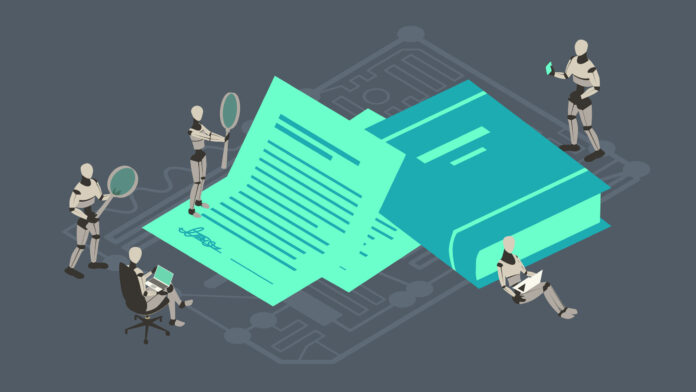
From invoices and contracts to customer feedback and research reports, the ability to efficiently organize and categorize unstructured data is vital for smooth operations. Here’s where Natural Language Processing (NLP) and document classification come into play.
Document classification, an application of NLP, is the process of teaching machines to recognize the patterns, keywords, and context within text data and subsequently sorting these documents into predefined categories. This means that a machine can autonomously identify an invoice, distinguish it from a customer feedback form, and route it to the appropriate department for further action. This capacity represents a leap forward in business efficiency.
Thanks to document classification, invoices can be promptly processed, contracts tracked, customer feedback analyzed in real-time, and research reports cataloged for future reference. This level of efficiency has far-reaching implications for a business, from faster decision-making and enhanced customer service to insights drawn from large volumes of data.
The Document Deluge
The volume of digital documents generated by businesses is expanding at an exponential rate. Invoices, emails, legal contracts, product manuals, and customer reviews—these documents hold critical information, but only if they can be efficiently accessed, analyzed, and managed. Manual categorization and sorting are not only time-consuming but also error-prone. This is why automation and NLP are becoming more and more indispensable.
Understanding Document Classification
Document classification is the process of automatically assigning predefined categories or labels to documents based on their content. It’s like teaching a machine to recognize patterns and context within text data, enabling it to sort documents into appropriate folders or databases. This process is crucial for a range of business activities, from organizing internal records to streamlining customer interactions.
The Role of NLP
Natural Language Processing, a branch of artificial intelligence, equips machines with the ability to understand, interpret, and generate human language. When applied to document classification, NLP enables computers to comprehend the content of text documents and categorize them based on the patterns, keywords, and context present.
Text Analysis
NLP-driven document classification employs text analysis techniques to break down documents into their constituent parts, such as words, phrases, and sentences. This analysis helps the system recognize relevant keywords and patterns within the text, forming the basis for categorization.
Machine Learning Models
NLP leverages machine learning algorithms to train models that can classify documents accurately. These models “learn” from a dataset of categorized documents, using features derived from the text, to make predictions about the category of new, unseen documents.
Language Understanding
NLP enables the system to understand the language’s nuances, including context, sentiment, and tone. This understanding can be invaluable for classifying documents accurately, especially in cases where context matters.
5 Benefits for Businesses
The automation of document classification through NLP offers several key benefits for businesses:
1. Time Efficiency
Manual document sorting is a time-consuming task. With NLP, the process becomes almost instantaneous, saving valuable time for employees to focus on more strategic and creative tasks.
2. Reduced Errors
Automation minimizes the risk of human errors in document categorization. NLP models can consistently and accurately classify documents, reducing the chances of misplacement or misinterpretation.
3. Enhanced Search and Retrieval
Once documents are accurately classified, they become much easier to find and retrieve. Businesses can quickly access relevant information, improving decision-making and customer service.
4. Data Insights
NLP can provide valuable insights into the content of documents. It can identify trends, extract key information, and help businesses make data-driven decisions.
5. Scalability
As businesses grow and document volumes increase, NLP-based document classification systems can easily scale to handle the load, ensuring operational efficiency.
Use Cases
Automating document classification through NLP finds applications in various industries:
- Legal: Sorting contracts, court documents, and case files.
- Finance: Categorizing financial reports, invoices, and statements.
- Healthcare: Organizing patient records, medical reports, and research papers.
- Customer Support: Routing customer queries to the right department.
- Retail: Classifying customer reviews and purchase orders.
Choosing the Right NLP Tools for Your Business: 11 Steps
Selecting the appropriate Natural Language Processing (NLP) tools is a critical decision when implementing NLP in your business. The right tools can make a substantial difference in the success of your NLP projects. Here’s a guide to help you choose the most suitable NLP tools for your specific business needs:
1. Define Your Objectives
Before diving into tool selection, it’s essential to define your NLP objectives. Are you aiming to improve customer support, automate data analysis, or enhance marketing efforts? Having a clear understanding of your goals will guide your tool selection.
2. Consider Pre-Trained Models
If your business is new to NLP, consider starting with pre-trained models. These models, like BERT, GPT-3, or spaCy, are already trained on vast text data and can be fine-tuned for your specific applications. They’re a great starting point for businesses without the resources for extensive custom training.
3. Open-Source Libraries
There are several open-source NLP libraries available, such as NLTK, spaCy, and gensim. These libraries provide a wide range of functionalities for text analysis, text mining, and natural language understanding. They are cost-effective and offer a degree of customization.
4. Cloud NLP Services
Major cloud providers like Google, Amazon, and Microsoft offer NLP services through their cloud platforms. These services, such as Google Cloud NLP and Amazon Comprehend, provide pre-built NLP models and APIs, making it relatively easy to integrate NLP into your applications and systems.
5. Custom Solutions
In some cases, businesses may require highly specialized NLP solutions. If your objectives demand a high degree of customization and control, you may consider building a custom NLP solution. This typically involves hiring data scientists and engineers experienced in NLP and machine learning.
6. User-Friendly Interfaces
Consider the usability of the NLP tools. User-friendly interfaces and dashboards can simplify the integration process and make it more accessible to non-technical staff in your organization.
7. Scalability and Performance
Assess the scalability and performance of the NLP tools. Ensure that the tools can handle your data volume and provide the required processing speed. Some NLP services offer scalable cloud-based solutions for handling large datasets.
8. Compatibility with Existing Systems
Compatibility with your existing systems and software is crucial. It’s essential to choose NLP tools that can seamlessly integrate with your current technology stack to avoid integration challenges and additional costs.
9. Data Security and Compliance
If your business handles sensitive data, ensure that the chosen NLP tools adhere to stringent data security and privacy standards. This is particularly important if you’re dealing with customer data, healthcare records, or any regulated information.
10. Cost and Budget
Consider the cost of the NLP tools and their fit with your budget. Some open-source libraries and tools are cost-effective, while cloud-based services may involve subscription fees. Balance the cost with the benefits you expect to gain.
11. Vendor Support and Community
Evaluate the level of vendor support and the presence of an active user community. Having access to support and a community of users can be invaluable when you encounter issues or need assistance.
12. Test and Experiment
Before committing to a specific NLP tool, conduct tests and experiments to ensure that it meets your business requirements. This allows you to assess its performance, ease of use, and compatibility with your data and objectives.
The NLP Revolution: Redefining Document Management for Business Success
Automating document classification through NLP is a game-changer for businesses drowning in data. It offers a powerful solution to the challenges of document management, boosting efficiency, reducing errors, and providing valuable insights. With the right implementation of NLP-driven document classification, businesses can harness the full potential of their unstructured data, gaining a competitive edge in today’s fast-paced business landscape.




